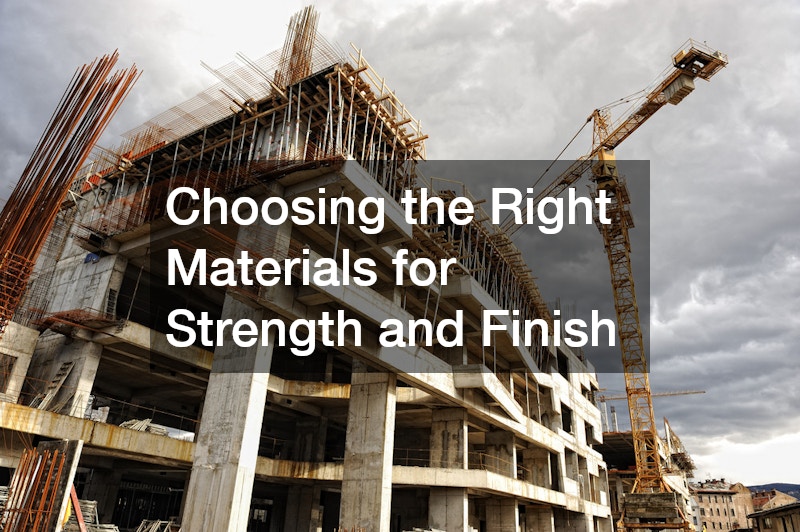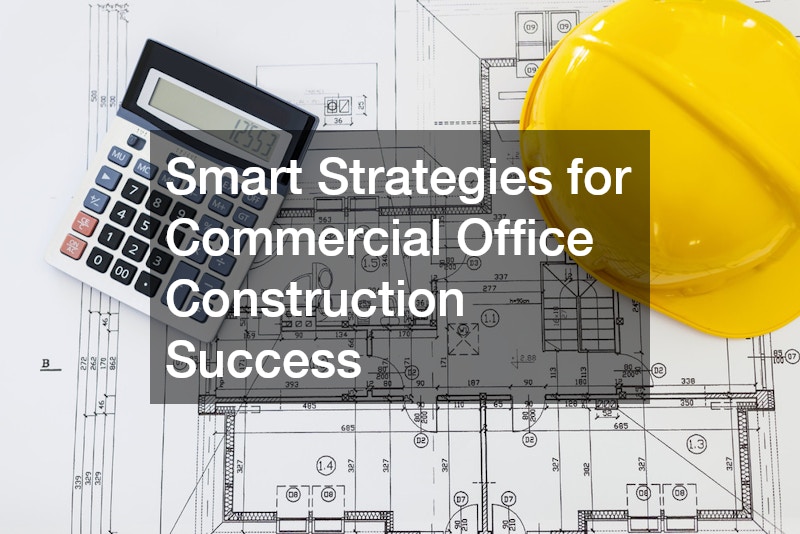Building a modern office space requires more than just blueprints and budgets—it demands a smart, strategic approach that balances design, functionality, and durability. Commercial office construction represents a significant investment for any business, and its success relies on careful planning, expert coordination, and quality craftsmanship. Whether you’re developing a new building or renovating an existing structure, each phase of the process must align with long-term business goals and operational efficiency.
A successful office construction project begins with vision and ends with performance. From excavation and framing to finishing and landscaping, each step contributes to how the final environment supports employees, clients, and growth. Business owners who take the time to plan carefully, select reliable contractors, and use high-quality materials can expect greater value, improved efficiency, and fewer costly surprises down the line.
Strategic collaboration is also key. Working with specialists ensures that every part of your project is executed with precision. Modern construction also involves integrating sustainability, safety, and comfort features that enhance both aesthetics and productivity. Smart builders today consider not only how the building looks but how it functions—how it breathes, powers, and sustains itself for decades to come.
This guide explores the essential stages and partnerships that define a successful commercial office construction project. From laying the groundwork to optimizing the finished space, these strategies can help businesses build efficiently, safely, and with lasting impact.
Laying the Groundwork for a Stable Foundation
Laying the groundwork in commercial construction requires the expertise of a local excavation contractor. These professionals are vital as they manage the land preparation, ensuring that the soil conditions are appropriate for support structures. An excavation contractor’s work also involves site grading, trenching, and ensuring proper drainage—key factors that affect the integrity of the foundation.
The precision and expertise of local excavation contractors set the stage for a successful build. They mitigate risks associated with unstable ground, such as settling or shifting, which can compromise the entire structure. By working closely with architects and engineers, they ensure that the site is optimally prepared to support the specific demands of commercial office construction. Early collaboration also helps identify potential challenges before construction begins, saving both time and resources. Their thorough planning contributes to the long-term stability and durability of the office building.
In commercial construction, the chosen groundworks contractor must also navigate local regulatory requirements and environmental considerations. This includes securing permits and adhering to rules that safeguard both the site and the community. Their role in maintaining sustainability and minimizing a project’s ecological footprint is becoming increasingly important in modern construction.

Building a Strong Structural Base
The cornerstone of any successful commercial office construction is a robust structural base, largely provided by a concrete contractor. As the primary material for foundations, floors, and structural elements, concrete demands precise formulation and application. A skilled concrete contractor ensures that the mix meets the necessary standards for strength and durability. Their attention to detail during curing and finishing processes also prevents common issues like cracking or uneven settling, which can compromise the building’s stability. Early involvement of the concrete contractor in project planning ensures that timelines and material logistics are optimized, reducing delays.
Concrete contractors play an integral role in shaping the building’s load-bearing components. They utilize advanced techniques to pour foundations, erect columns, and create frames that can withstand environmental stresses. Their expertise guarantees that these components align perfectly with architectural blueprints and structural engineering specifications.
Furthermore, they incorporate modern innovations like high-performance concrete and reinforced precast panels, which significantly enhance structural integrity. By blending traditional craftsmanship with new technologies, concrete contractors help to redefine the longevity and resilience of modern office buildings.
Custom Components That Strengthen Design
In commercial construction, custom components such as those provided by metal fabrication specialists can elevate a building’s design and functionality. Metal fabrication involves the crafting of structural steel beams, staircases, and bespoke architectural features that are essential to modern office aesthetics and functionality.
Metal fabrication experts collaborate closely with architects to achieve seamless integration of design elements. Their work allows for creative freedom while maintaining the vital balance between form and function. Custom metal components contribute to a unique office environment, fostering a distinctive corporate identity through innovative design.
The versatility of metal as a material offers numerous advantages in terms of strength, longevity, and versatility, making it a staple in commercial office construction. With the incorporation of lightweight yet sturdy alloys, the metal fabrication process also supports sustainability initiatives, reducing the overall mass and carbon footprint of a building.

Choosing the Right Materials for Strength and Finish
Opting for materials that offer both structural integrity and aesthetic appeal is crucial in commercial office construction. Industrial plywood suppliers provide an array of engineered wood products that balance these needs. Known for their strength and versatility, plywood panels are used in various applications from interior wall finishes to roofing subsystems.
Plywood offers significant advantages due to its layering process, which enhances durability and resistance to environmental changes. In commercial office spaces, plywood is used not only for its practical benefits but also for its ability to deliver sleek, modern aesthetics. It is an essential component in any office construction project striving for both functional precision and visual appeal.
When sourced from responsible industrial plywood suppliers, these materials also contribute to sustainable building practices. By selecting certified wood, developers can ensure compliance with green building standards, making the construction process more eco-friendly without compromising on quality.
Coordinating the Entire Construction Process
Successful commercial construction relies heavily on the coordination provided by an experienced commercial builder. This professional oversees all aspects of the project, ensuring that timelines are met and resources are optimally allocated. Their leadership is crucial in translating architectural designs and engineering plans into a practical reality.
From managing subcontractors to overseeing procurement, a commercial builder orchestrates the entire construction process. They serve as the communication nexus between architects, engineers, and tradespeople, ensuring that every element of the project functions in harmony. Their role is to troubleshoot problems before they escalate, maintaining the project schedule and budget.
The ability to maintain a cohesive work environment is paramount in commercial office construction. A builder’s adept project management skill facilitates smooth transitions during various phases of the project, promoting a culture of collaboration and excellence at every stage of development.

Protecting Your Investment From the Top Down
The importance of commercial roofing in commercial office construction cannot be understated. A robust roofing system protects the building from environmental elements, preserving the interior environment and safeguarding investments. Quality roofing is a barrier against rain, wind, and UV rays, directly affecting the building’s energy efficiency and longevity.
Commercial roofing specialists are tasked with selecting materials that suit the structural design and climate considerations of the area. Whether opting for metal roofs, TPO membranes, or green roofing technologies, the choices made here have a lasting impact on maintenance and operational costs.
Furthermore, maintaining a focus on energy efficiency is increasingly important, and modern commercial roofing solutions include reflective or insulated materials that minimize cooling demands in office spaces. Sustainable roofing practices not only contribute to lower utility costs but also improve the building’s environmental impact, aligning with many tenants’ corporate responsibility goals.
Designing for Comfort and Efficiency
Creating a comfortable and efficient working environment is a central concern in commercial office construction. HVAC services play a pivotal role in maintaining optimum temperature, humidity, and air quality—factors that significantly impact employee wellbeing and productivity.
Modern HVAC systems are designed to adapt to the building’s varying needs, offering zoned climate control and energy efficiency. These systems are also crucial in maintaining a healthy workspace by filtering the air to reduce allergens and pollutants. The implementation of smart HVAC technologies enables precise control over the office environment, driving both comfort and sustainability.
Moreover, HVAC services go beyond installation; they include ongoing maintenance and optimization to ensure consistent performance. This comprehensive approach supports the superior operational standards demanded in commercial office environments, enhancing both employee satisfaction and business performance.

Integrating Essential Building Infrastructure
In the realm of commercial office construction, plumbing services form an indispensable part of the infrastructure. Professional plumbers ensure that water systems are efficiently laid out and securely installed, addressing everything from sanitation to modern amenity facilities. Their expertise also extends to ensuring compliance with local codes and regulations, which safeguards both occupants and the building owner. Early collaboration with other contractors helps prevent conflicts with electrical, HVAC, and structural systems, streamlining the construction process.
Plumbing solutions must meet the specific demands of office environments, requiring durability and reliability. They not only cover basic necessities like restrooms and kitchens but also integrate with building design to align with the architect’s vision. This coordination ensures that plumbing systems contribute positively to the functionality and aesthetics of the commercial office space.
The ongoing maintenance of plumbing systems remains critical, too. Routine inspections and upgrades are necessary to prevent disruptions, reduce water waste, and comply with environmental standards. The consistent performance of these systems is essential for maintaining a seamless operation in any commercial setting.
Powering Performance Through Reliable Systems
Reliable electrical systems are at the heart of any successful commercial office construction project. The role of a wholesale electrical supplier is to provide dependable, high-quality electrical components to support the demanding needs of modern offices. These systems must be robust enough to accommodate everything from standard office equipment to advanced IT infrastructures. Careful planning with suppliers also ensures that wiring and component specifications meet both current requirements and anticipated future needs. By selecting trusted suppliers, contractors minimize the risk of system failures and costly retrofits.
Utilizing state-of-the-art electrical solutions enhances both the safety and efficiency of the office building. Circuit designs are planned to optimize energy use, integrate backup power solutions, and offer scalability for future expansions. In this manner, offices can accommodate cutting-edge technologies without unforeseen power shortages or safety concerns.
Wholesale electrical suppliers thus play a crucial part in implementing green building practices. The push for energy-efficient solutions, such as LED lighting and automated control systems, helps reduce operational costs and supports corporate sustainability initiatives, making a significant difference in a commercial office’s environmental footprint.
Enhancing Curb Appeal and Outdoor Usability
Landscaping plays an indispensable role in commercial office construction by boosting curb appeal and enhancing the usability of outdoor spaces. The thoughtful design of landscapes around office buildings creates an inviting atmosphere, contributing positively to first impressions while providing functional outdoor areas for employees and visitors.
Professional landscaping involves selecting plant species that thrive in the local climate, are easy to maintain, and support environmental sustainability. Hardscaping elements like paths, patios, and water features complement the architecture of the office building while ensuring accessibility and security.
Landscaping is not only about aesthetics; it impacts the microenvironment around the building. Strategic planting can improve air quality, manage stormwater, reduce urban heat effects, and create habitats for local wildlife. By integrating natural elements, an office can offer serene environments that enhance the overall satisfaction and productivity of those who work there.
Commercial office construction is an intricate and multifaceted process that demands attention to detail, collaboration among skilled professionals, and the strategic selection of both materials and methods. This guide has explored many essential components of successful office building projects, highlighting the vital roles played by local excavation contractors, concrete and metal fabrication specialists, and other critical service providers.
The importance of choosing the right commercial builder, HVAC services, and reliable electrical systems cannot be understated, as each contributes to an office’s functionality and overall success. Similarly, commercial roofing and plumbing services ensure the sustainability of investment by prioritizing efficiency and resilience. By focusing on quality design and materials, each phase of the construction process supports the creation of an office that is both productive and appealing.
The culmination of these efforts results in a commercial space that not only meets contemporary business demands but is also prepared for future challenges. Through careful coordination and a commitment to excellence, commercial construction continues to evolve, offering innovations that drive efficient, attractive, and sustainable workplaces.
